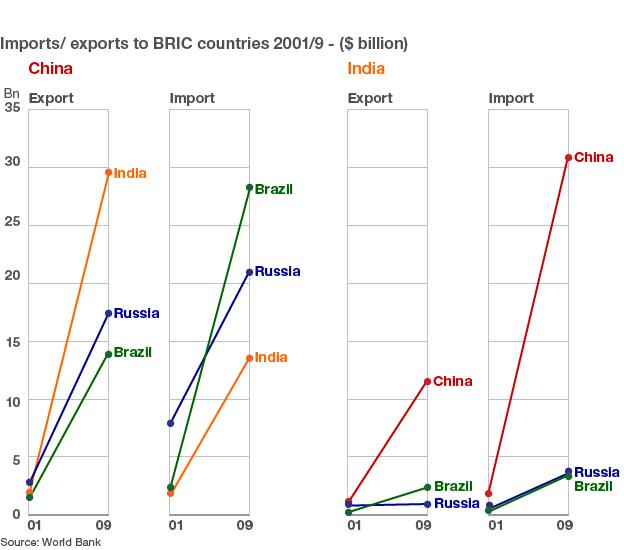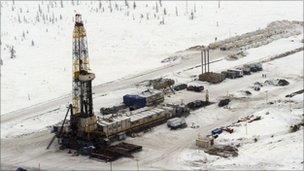Bric nations become increasingly interdependent
- Published
China plays host on Thursday to the third summit of Bric nations, as it and other emerging economies increasingly drive global growth.
The leaders of Brazil, Russia, India and China will meet on Hainan Island, along with potential new member, South Africa.
The term Bric was coined in 2001 by Goldman Sachs economist Jim O'Neill to group together the four fast-rising economies.
In recent months their economic might has been matched by their growing political influence.
The four are part of the G20, a grouping of the major economies in the world.
The Bric countries recovered quickly from the global financial crisis in 2008, proving they were not as vulnerable to a downturn in the US and Europe.
With the developed world not looking to do business, these countries are turning to each other, and smaller emerging economies.

Brazil
Brazil's has traditionally exported commodities and minerals to the US and Europe, but Chinese demand is changing the equation for Brazil's agriculture.
The soybean industry in particular has shown rapid growth in order to meet the demand of China's population.
This week, China authorised some Brazilian pork producers to start exporting to the country for the first time.
"You can see the shift taking place in terms of re-orientation of the Brazilian agriculture towards China," said Benjamin Selwyn, from the International Relations and Development Studies department at the University of Sussex.
China is also hungry for Brazil's other commodities, such as iron ore to manufacture steel, which is being used in its huge construction boom.
Last year China overtook the US as Brazil's biggest trade partner with more than $56bn in trade.
Beyond commodities, Brazil has also found a market in China for some of its manufactured goods.
This week Brazilian President Dilma Rouseff signed a deal in China for Embraer, the third largest maker of commercial aircrafts in the world, to sell planes to Chinese airlines, cashing in on the mainland's fast expanding air travel market.
Russia

Oil produced in Siberia has helped make Russia the world's largest producer of commodities
While China may be the world's biggest consumer, Russia is the largest global producer of many commodities.
Russia has traditionally been - and continues to be - a large natural resource exporter. However, where it exports to has changed dramatically in the past 10 years.
Trade with Asia has increased at the expense of business with the US and former Soviet Union countries.
Asia's economic growth, and the push within Russia to develop trade ties outside its traditional partners in Europe, have now made China Russia's largest trade partner, ahead of Germany.
"China is Russia's economic future," said Roland Nash, of Verno Investment Research in Moscow.
"Both require each other to fuel economic growth. China sets the price for many of the world's natural resources through demand and Russia through supply."
India
India is a global leader as a provider of services, practically inventing the outsourcing industry.
Unlike Brazil and Russia, which have built their economies on commodities exports, India has developed its people.
Along with computer services, the medical-care industry has taken huge strides.
But it has failed to become a mass manufacturer like the other Bric countries, and as a result still imports much of its manufactured goods from China.
This means that although China is now India's largest trade partner, India runs a large trade deficit with the country.
"There is an asymmetry in their relationship," said Taimur Baig, from Deutsche Bank.
China
China has reinvented itself and is now a mass producer of hi-tech products, including semi-conductors and solar panels.
It also still continues to be a large producer of low-cost, high-value industries, like garments and textiles.
"Its about maintaining competitiveness in the global economy," said Damian Tobin, from the School of Oriental and African Studies at the University of London.
"Low-cost manufacturing is intensely driven by the labour cost component, if that starts to rise then a lot of firms will look for the next cheapest alternatives like Vietnam," he added.
To maintain growth in manufacturing, China has increasingly turned towards more high-tech products.
In the past year, China has successfully won contracts to build high-speed rail around the world, after it became the global leader in the industry and is now home to the world's fastest train.
Just this week Brazil said it would allow Chinese companies to bid for a planned high-speed rail project.
The four Bric countries are united in their hunger for raw material to feed their rapid growth.
China has led the way in looking for resources around the globe but has been followed by Brazil, Russia and India
"China has been very pragmatic in reaching out across the board, all the way to Africa and Latin America, to secure supplies of commodities and at the same time creating markets for its own exports," said Taimur Baig, chief economist at Deutsche Bank in Singapore.
But they don't agree on everything.
Brazil and India have expressed concern about China flooding their markets with cheap goods, sparking a debate about the value of the yuan.
Most analysts agree that giving these four countries an acronym does not mean they will act as one on the global stage.
"I wouldn't expect the Brazilians or the Chinese to say Bric means a new configuration of the world. It's a longer process of seeing what gains can be made from collaboration with the G20 and other countries," said Mr Selwyn.
Even though the Bric countries are decreasing their dependence on developed economies, on a global stage they still need to work with the major industrialised nations.